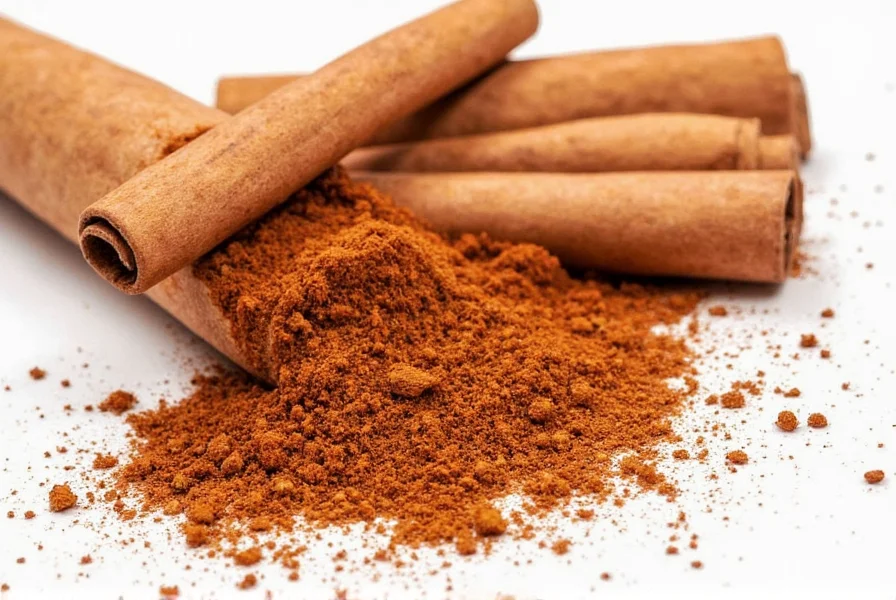Most people don't realize that what's commonly sold as "regular cinnamon" is actually Cassia, which contains high levels of coumarin—a compound that can cause liver damage with regular high consumption. In this guide, we break down the critical differences between Ceylon and Cassia cinnamon, including health implications, flavor profiles, and how to identify each type to make safe, informed choices for your kitchen.
- What Is Cinnamon?
- Ceylon vs. Cassia: Key Differences
- Flavor & Aroma Compared
- Health Considerations: Coumarin Risks & Safety
- Uses in Cooking and Baking
- How to Tell Them Apart
- Buying Guide: What to Look For
- Frequently Asked Questions
- Conclusion
What Is Cinnamon?
Cinnamon is a beloved spice derived from the inner bark of trees from the Cinnamomum genus. When dried, the bark curls into rolls known as quills. Ground cinnamon is simply these quills ground into powder form.
While both types come from related species, they have very different characteristics:
- Ceylon Cinnamon: Known as "true" cinnamon, it's native to Sri Lanka.
- Cassia Cinnamon: Commonly labeled as 'regular' cinnamon, it's cheaper and widely used, mostly coming from China or Indonesia.
| Feature | Ceylon Cinnamon | Cassia Cinnamon |
|---|---|---|
| Origin | Sri Lanka | China, Indonesia, Vietnam |
| Appearance | Thin, multi-layered quills | Thick, hard single-layer sticks |
| Color | Pale brown to tan | Reddish-dark brown |
| Texture | Fragile and crumbly | Hard and fibrous |
| Price | Higher | Affordable |
| Coumarin Content | Very low (0.004-0.1%) | High (0.4-1.2%) |
| Taste | Mild, sweet, complex | Strong, spicy, slightly bitter |
Ceylon vs. Cassia: Key Differences
When you buy "cinnamon" in most U.S. grocery stores, you're typically getting Cassia. Ceylon is more expensive and less common. Here's a detailed comparison of their key differences:
Flavor & Aroma Compared
Understanding flavor differences helps choose the right cinnamon for your recipes:
- Ceylon Cinnamon: Softer, sweeter, and more complex. Ideal for delicate dishes where subtle spice is needed.
- Cassia Cinnamon: Bold, spicy, and slightly bitter. Perfect for robust baked goods and hearty dishes.
Health Considerations: Coumarin Risks & Safety
Both varieties contain antioxidants and anti-inflammatory compounds, but coumarin is the critical difference:
- Cassia contains high coumarin levels (0.4-1.2%), which can cause liver damage with regular high consumption.
- The European Food Safety Authority (EFSA) recommends a maximum daily coumarin intake of 0.1 mg per kg of body weight. For most adults, this means limiting Cassia to 1-2 teaspoons daily.
- Ceylon cinnamon has negligible coumarin (0.004-0.1%), making it safe for daily or therapeutic use.
For supplements or regular high consumption, Ceylon is the only safe choice. For typical culinary use, Cassia is generally safe within recommended limits.
Uses in Cooking and Baking
Choosing the right cinnamon depends on your recipe:
Ceylon Cinnamon Use Cases:
- Delicate desserts like custards, puddings, and fine pastries
- Teas and warm beverages
- Spiced cocktails
- International dishes from India, the Middle East, and North Africa
Cassia Cinnamon Use Cases:
- Bold baked goods like cinnamon rolls, snickerdoodles, and pumpkin pie
- Meat rubs, especially for lamb and pork
- Hot drinks like mulled wine
- Commercial spice blends (e.g., garam masala, Chinese five-spice)
How to Tell Them Apart
Identify cinnamon types easily with these methods:
- Visual Check: Ceylon sticks are thin, papery, and layered; Cassia sticks are thick, woody, and single-layered.
- Texture Test: Ceylon snaps easily and crumbles; Cassia is tough and resists breaking.
- Taste Test: Ceylon is sweet and mild; Cassia is strong, spicy, and slightly bitter.
Buying Guide: What to Look For
| Product Type | Description | Best For | Key Features |
|---|---|---|---|
| Ceylon Sticks | Whole cinnamon quills from Sri Lanka | Teas, infusions, and gourmet cooking | Natural aroma, mild flavor, low coumarin |
| Ceylon Powder | Ground Ceylon cinnamon | Smooth-textured baking, spice blends | Easier to use, still safe for daily use |
| Cassia Sticks | Thick, woody cinnamon quills | Spicing broths, marinades, and hearty stews | Strong flavor, affordable, long shelf life |
| Cassia Powder | Common ground cinnamon found in stores | Baking, commercial use, spiced drinks | Robust flavor, economical, but higher coumarin |
Shopping Tips:
- Read labels carefully — look for "Ceylon", "True Cinnamon", or "Cinnamomum verum"
- Check if the brand specifies origin (Sri Lanka for Ceylon) and coumarin content
- Purchase from reputable sources like specialty spice shops or certified organic brands
- Store in airtight containers away from light and moisture
Frequently Asked Questions
What is the main difference between Ceylon and Cassia cinnamon?
The main difference is coumarin content and physical characteristics. Ceylon cinnamon (true cinnamon) has negligible coumarin (0.004-0.1%), thin multi-layered quills, and a mild sweet flavor. Cassia cinnamon has high coumarin (0.4-1.2%), thick single-layer sticks, and a strong spicy taste. Ceylon comes from Sri Lanka while Cassia is primarily from China, Indonesia, or Vietnam.
Why is Ceylon cinnamon more expensive than regular cinnamon?
Ceylon requires labor-intensive harvesting from the Cinnamomum verum tree, with only 1kg produced from 25kg of bark. Cassia comes from faster-growing trees with thicker bark that's easier to harvest in larger quantities, making it significantly cheaper.
Is Cassia cinnamon bad for you?
Cassia is safe for typical culinary use within EFSA guidelines (1-2 teaspoons daily for adults), but its high coumarin content can cause liver damage with regular high consumption. For supplements or therapeutic use, Ceylon is the only safe option due to negligible coumarin.
How much cinnamon can I safely consume daily?
For Cassia: Limit to 1-2 teaspoons (2-4g) daily. For Ceylon: Up to 1-2 tablespoons (6-12g) daily. If using supplements, consult a healthcare provider, especially with liver conditions or blood thinners.
Can I substitute Ceylon cinnamon for Cassia in recipes?
Yes, but adjust quantities. Use 1.5x more Ceylon for the same flavor intensity. For delicate recipes like custards, Ceylon works perfectly. For bold recipes like cinnamon rolls, blend both types or increase Ceylon slightly.
Where can I buy Ceylon cinnamon?
Find Ceylon at specialty spice shops, gourmet food stores, or reputable online retailers. Look for labels specifying "Ceylon", "True Cinnamon", "Cinnamomum verum", or "Sri Lankan origin". Avoid generic "cinnamon" labels without origin details.
Conclusion
Both cinnamon types have unique strengths. For health-conscious cooking, daily use, or therapeutic purposes, Ceylon is the safer choice due to negligible coumarin. For bold baked goods and cost-effective cooking, Cassia remains popular within safe consumption limits. Always check labels for "Ceylon" or "Cassia" to make informed choices.
Now that you know the critical differences, you can confidently choose the right cinnamon for every recipe while prioritizing your health.












 浙公网安备
33010002000092号
浙公网安备
33010002000092号 浙B2-20120091-4
浙B2-20120091-4